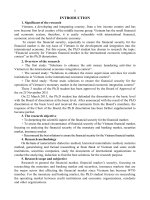Financial accounting in an economic context 8e chapter 01
Bạn đang xem bản rút gọn của tài liệu. Xem và tải ngay bản đầy đủ của tài liệu tại đây (597.59 KB, 21 trang )
Chapter 1:
Financial Accounting
and
Its Economic Context
2
The Role of Financial Reporting in
Investment Decisions
Profit-seeking companies - managers
prepare reports for owners of the
companies.
Owners and other interested parties
(Users) - use reports to assess financial
condition and performance of companies.
User decisions - users obtain information
from reports to make investment decisions.
Effects of user decisions - decisions affect
the company and its managers.
3
Financial Reporting and
Investment Decisions
4
Content of Financial Reports
The Management Letter
The Financial Statements:
–
–
–
–
Balance Sheet
Income Statement
Statement of Shareholders’ Equity
Statement of Cash Flows
The Footnotes
– integral part of the financials, and explain many of
the policies and assumptions used to prepare the
financials.
The Auditor’s Report
5
The Management Letter
The management letter is the statement
of management to the investors.
It indicates:
– management is responsible for the
preparation and content of the financial
report.
– the statements were prepared in accordance
with generally accepted accounting principles
(GAAP).
– the company maintains a system of internal
controls to safeguard assets.
6
7
The Auditor’s Report
The auditor’s report is a statement to the
board of directors of the company and to the
shareholders of the company.
It expresses an opinion as to whether the
financial statements present fairly the
financial activities of the company and
whether the financials were prepared in
accordance with GAAP
8
The Economic Environment of
Financial Reporting
Providers of capital - debt and equity
investors
Reporting entities
Corporate governance
– Financial information users and capital markets
– Debt covenants and management compensation
Financial reporting regulations & standards
– the accounting policymaking process
Sarbanes-Oxley Act
Legal liability
Professional reputation and ethics
9
Providers of Capital
Provide capital
– equity capital through stock investments
– debt capital through bond and loan investments
(creditors)
Receive returns
– equity investors receive dividends
– creditors and bond investors receive interest
Stock investors choose board of directors
Board of directors
– Select corporate officers (management)
– Set company policy
– Select audit committee
Management – runs the company
10
Reporting Entities
Reporting entities are called companies,
businesses and firms.
The companies may be further divided into
segments and subsidiaries, which may
provide their own financials.
Consolidated financials are prepared when
subsidiaries are combined with the parent’s
financials.
11
Corporate Governance
Financial Information Users
Financial statements used by a variety of groups.
– Equity investors:
purchase shares of stock, which represent
ownership in the company. The financials are used
by investors to analyze management’s decisions.
– Debt investors (creditors):
provide capital through loans. The financials are
used by creditors to assess likelihood of default.
– Management:
uses other companies financials to asses the
competition.
– Others, including government bodies, labor
unions, employees, use financials to assess the
financial status of the company.
12
Corporate Governance
and Capital Markets
Capital markets value the publicly traded
equity and debt securities.
The financials are a component of the
information that the markets use to value
companies securities, along with a number of
nonfinancial measures.
The market reacts to financial and other
information as it is released by management.
13
Debt Covenants and Management
Compensation Contracts
Debt covenants are part of debt contracts
between the company and creditors.
Violation of debt covenants may lead to more
costly debt terms.
Management compensation contracts often
base pay on certain income or stock price
goals.
Such goals are designed to encourage
certain management behavior.
14
Regulations and Standards
The Securities and Exchange Commission (SEC)
governs financial reporting for publicly traded
companies. Congress and other regulatory
agencies have influence with the SEC.
The Financial Accounting Standards Board (FASB)
is responsible for the promulgation of generally
accepted accounting principles (GAAP) for financial
statements. The FASB accepts input from all
interested parties, including accountants,
corporations, academics, and governmental
entities.
15
The Accounting
Policymaking Process
Policymakers
Congress, White House,
government agencies
SEC
Public hearings, letters
FASB
Generally Accepted
Accounting Principles
Public
Input
(GAAP)
Actual Accounting
Practices
Economic Consequences
Perceived
economic
consequences
Sarbanes-Oxley Act
Passed by Congress in 2002, in response to
a series of corporate scandals.
Requires principal executive and financial
officers to certify a number of statements
regarding the financials.
Places additional responsibilities on
management to ensure that adequate internal
controls are in place.
17
Legal Liability
Management is legally responsible to the
shareholders to act in their interest.
Auditors are legally responsible to the
shareholders to conduct a thorough and
independent audit.
If management or auditors fail in their duties,
investors and others may sue to recover any
losses that might occur as a result the failure.
Many recent examples of management and audit
failure exist: Enron, WorldCom, HealthSouth,
Xerox, Rite Aid, and Qwest.
18
Professional Reputation and Ethics
Ethical behavior is in the long-run interest of
managers, shareholders, and auditors.
Many companies, universities, and
professional organizations have enacted
increased emphasis on ethics.
Auditors’ reputations are integral to their
ability to perform their duties. High ethical
conduct is imperative to their continued
success.
19
Four Kinds of Accounting
20
Copyright
Copyright © 2011 John Wiley & Sons, Inc. All rights reserved.
Reproduction or translation of this work beyond that
permitted in Section 117 of the 1976 United States Copyright
Act without the express written permission of the copyright
owner is unlawful. Request for further information should be
addressed to the Permissions Department, John Wiley &
Sons, Inc. The purchaser may make back-up copies for his/her
own use only and not for distribution or resale. The Publisher
assumes no responsibility for errors, omissions, or damages,
caused by the use of these programs or from the use of the
information contained herein.
21









